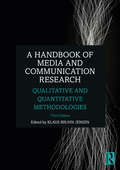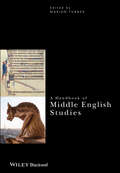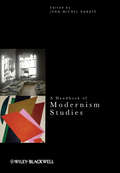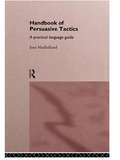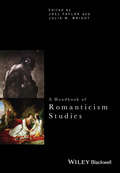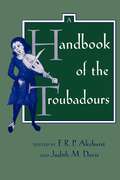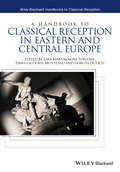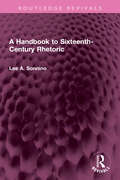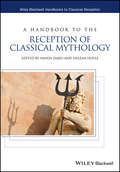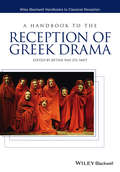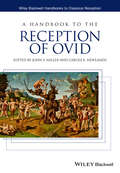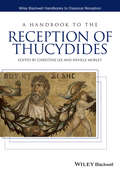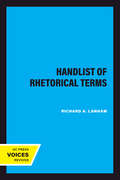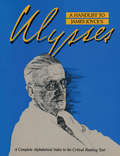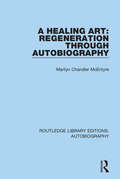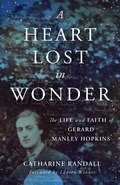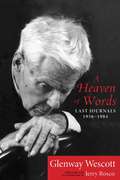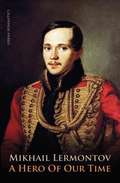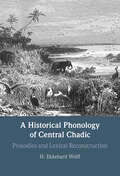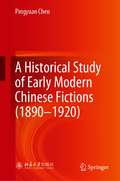- Table View
- List View
A Handbook of Media and Communication Research: Qualitative and Quantitative Methodologies
by Klaus Bruhn JensenThoroughly revised and updated, this third edition integrates perspectives from the social sciences and the humanities, focusing on methodology as a strategic level of analysis that joins practical applications with theoretical issues. The Handbook comprises three main elements: historical accounts of the development of key concepts and research traditions; systematic reviews of media organizations, discourses, and users, as well as of the wider social and cultural contexts of communication; and practical guidelines with sample studies, taking readers through the different stages of a research process and reflecting on the social uses and consequences of research. Updates to this edition include: An overview of the interrelations between networked, mass, and interpersonal communication. A new chapter on digital methods. Three chapters illustrating different varieties of media and communication research, including industry–academic collaboration and participatory action research. Presentation and discussion of public issues such as surveillance and the reconfiguration of local and global media institutions. This book is an invaluable reference work for students and researchers in the fields of media, communication, and cultural studies.
A Handbook of Middle English Studies
by Marion TurnerA Handbook to Middle English Studies presents a series of original essays from leading literary scholars that explore the relationship between critical theory and late medieval literature.Includes 26 new essays by leading scholars of late medieval literatureSets the new standard for an introduction to the study of late medieval literatureShowcases the most current cutting-edge theoretical researchDemonstrates a range of approaches to late medieval literatureBrings together critical theory and medieval literature
A Handbook of Modernism Studies
by Jean-Michel RabatéFeaturing the latest research findings and exploring the fascinating interplay of modernist authors and intellectual luminaries, from Beckett and Kafka to Derrida and Adorno, this bold new collection of essays gives students a deeper grasp of key texts in modernist literature. Provides a wealth of fresh perspectives on canonical modernist texts, featuring the latest research data Adopts an original and creative thematic approach to the subject, with concepts such as race, law, gender, class, time, and ideology forming the structure of the collection Explores current and ongoing debates on the links between the aesthetics and praxis of authors and modernist theoreticians Reveals the profound ways in which modernist authors have influenced key thinkers, and vice versa
A Handbook of Persuasive Tactics: A Practical Language Guide
by Joan MulhollandMost people have to communicate with colleagues every day and persuade them to understand their opinions or to accept their views. This handbook is intended for anyone who is interested in such goal-oriented language. It extracts 300 persuasive tactics from research findings in communication, linguistics, pragmatics and related fields, and presents them in a clear, concise and consistent manner. Such tactics as analogy, argument presentation, humour and metaphor are included. Each tactic is presented on a separate page with an analysis of its persuasive value. Two indexes - one by persuasive need and the other by tactic - allow readers full flexibility to use the handbook in their own way. This work should be of interest in courses which deal with the management of interaction, pragmatics, discourse analysis and communications.
A Handbook of Romanticism Studies (Critical Theory Handbooks #6)
by Joel Faflak Julia M. WrightThe Handbook to Romanticism Studies is an accessible and indispensible resource providing students and scholars with a rich array of historical and up-to-date critical and theoretical contexts for the study of Romanticism. Focuses on British Romanticism while also addressing continental and transatlantic Romanticism and earlier periods Utilizes keywords such as imagination, sublime, poetics, philosophy, race, historiography, and visual culture as points of access to the study of Romanticism and the theoretical concerns and the culture of the period Explores topics central to Romanticism studies and the critical trends of the last thirty years
A Handbook of the Troubadours (Center for Medieval and Renaissance Studies, UCLA #26)
by F. R. Akehurst Judith M. DavisThis book is a reference volume and a digest of more than a century of scholarly work on troubadour poetry. Written by leading scholars, it summarizes the current consensus on the various facets of troubadour studies.Standing at the beginning of the history of modern European verse, the troubadours were the prime poets and composers of the twelfth and thirteenth centuries in the South of France. No study of medieval literature is complete without an examination of the courtly love which is celebrated in the elaborately rhymed stanzas of troubadour verse, creations whose words and melodies were imitated by poets and musicians all over medieval Europe.The words of about 2,500 troubadour songs have survived, along with 250 melodies, and all have come under intense scholarly scrutiny. This Handbook brings together the fruits of this scrutiny, giving teachers and students an overview of the fundamental issues in troubadour scholarship. All quotations are given in the original Old Occitan and in English. The editors provide a list of troubadour editions and an index, and each chapter includes a list of additional readings.
A Handbook to Classical Reception in Eastern and Central Europe (Wiley Blackwell Handbooks to Classical Reception)
by Dorota Dutsch Zara Martirosova Torlone Dana LaCourse MunteanuA Handbook to Classical Reception in Eastern and Central Europe is the first comprehensive English9;]language study of the reception of classical antiquity in Eastern and Central Europe. This groundbreaking work offers detailed case studies of thirteen countries that are fully contextualized historically, locally, and regionally. The first English-language collection of research and scholarship on Greco-Roman heritage in Eastern and Central Europe Written and edited by an international group of seasoned and up-and-coming scholars with vast subject-matter experience and expertise Essays from leading scholars in the field provide broad insight into the reception of the classical world within specific cultural and geographical areas Discusses the reception of many aspects of Greco-Roman heritage, such as prose/philosophy, poetry, material culture Offers broad and significant insights into the complicated engagement many countries of Eastern and Central Europe have had and continue to have with Greco-Roman antiquity
A Handbook to Eddic Poetry
by Carolyne Larrington Judy Quinn Brittany SchornThis is the first comprehensive and accessible survey in English of Old Norse eddic poetry: a remarkable body of literature rooted in the Viking Age, which is a critical source for the study of early Scandinavian myths, poetics, culture and society. Dramatically recreating the voices of the legendary past, eddic poems distil moments of high emotion as human heroes and supernatural beings alike grapple with betrayal, loyalty, mortality and love. These poems relate the most famous deeds of gods such as #65533;#65533;inn and #65533;#65533;rr with their adversaries the giants; they bring to life the often fraught interactions between kings, queens and heroes as well as their encounters with valkyries, elves, dragons and dwarfs. Written by leading international scholars, the chapters in this volume showcase the poetic riches of the eddic corpus, and reveal its relevance to the history of poetics, gender studies, pre-Christian religions, art history and archaeology.
A Handbook to Sixteenth-Century Rhetoric (Routledge Revivals)
by Lee A. SonninoFirst published in 1968, A Handbook to Sixteenth-Century Rhetoric is designed primarily to assist the student of renaissance literature in the science of rhetoric. It gathers together the information provided by the various different authorities who contributed to the education of the renaissance author, particularly the writer in English. These authorities include key classical rhetoricians he would probably have read, well-known and important renaissance rhetoricians, and the writers of vernacular treatises and of major school textbooks. The information is arranged in a schematic and tabular form, so that enquiry can start from the object, the particular rhetorical form as it appears in a given literary text. The core of the book is the central section on elocutio, the art of using the devices of rhetorical ornament.
A Handbook to the Reception of Classical Mythology (Wiley Blackwell Handbooks to Classical Reception)
by Vanda Zajko Helena HoyleA Handbook to the Reception of Classical Mythology presents a collection of essays that explore a wide variety of aspects of Greek and Roman myths and their critical reception from antiquity to the present day. Reveals the importance of mythography to the survival, dissemination, and popularization of classical myth from the ancient world to the present day Features chronologically organized essays that address different sets of myths that were important in each historical era, along with their thematic relevance Features chronologically organized essays that address different sets of myths that were important in each historical era, along with their thematic relevance Offers a series of carefully selected in-depth readings, including both popular and less well-known examples
A Handbook to the Reception of Greek Drama (Wiley Blackwell Handbooks to Classical Reception)
by Betine van Zyl SmitA Handbook to the Reception of Greek Drama offers a series of original essays that represent a comprehensive overview of the global reception of ancient Greek tragedies and comedies from antiquity to the present day. Represents the first volume to offer a complete overview of the reception of ancient drama from antiquity to the present Covers the translation, transmission, performance, production, and adaptation of Greek tragedy from the time the plays were first created in ancient Athens through the 21st century Features overviews of the history of the reception of Greek drama in most countries of the world Includes chapters covering the reception of Greek drama in modern opera and film
A Handbook to the Reception of Ovid (Wiley Blackwell Handbooks to Classical Reception)
by Carole E. Newlands John F. MillerA Handbook to the Reception of Ovid presents more than 30 original essays written by leading scholars revealing the rich diversity of critical engagement with Ovid’s poetry that spans the Western tradition from antiquity to the present day. Offers innovative perspectives on Ovid’s poetry and its reception from antiquity to the present day Features contributions from more than 30 leading scholars in the Humanities. Introduces familiar and unfamiliar figures in the history of Ovidian reception. Demonstrates the enduring and transformative power of Ovid’s poetry into modern times.
A Handbook to the Reception of Thucydides (Wiley Blackwell Handbooks to Classical Reception)
by Christine LeeA Handbook to the Reception of Thucydides offers an invaluable guide to the reception of Thucydides, with a strong emphasis on comparing and contrasting different traditions of reading and interpretation. • Presents an in-depth, comprehensive overview of the reception of the Greek historian Thucydides • Features personal reflections by eminent scholars on the significance and perennial importance of Thucydides’ work • Features an internationally renowned cast of contributors, including established academics as well as new voices in the field
A Handlist of Rhetorical Terms
by Richard A. LanhamWith a unique combination of alphabetical and descriptive lists, A Handlist of Rhetorical Terms provides in one convenient, accessible volume all the rhetorical terms—mostly Greek and Latin—that students of Western literature and rhetoric are likely to come across in their reading or will find useful in their writing. The Second Edition of this widely used work offers new features that will make it even more useful:* A completely revised alphabetical listing that defines nearly 1,000 terms used by scholars of formal rhetoric from classical Greece to the present day* A revised system of cross-references between terms* Many new examples and new, extended entries for central terms* A revised Terms-by-Type listing to identify unknown terms* A new typographical design for easier access
A Handlist to James Joyce's Ulysses: A Complete Alphabetical Index to the Critical Reading Text
by Hans Walter Gabler Wolfhard SteppeFirst published in 1986, this book provides a handlist to James Joyce’s Ulysses, or a complete alphabetical index to the critical reading text, that is, the text on the right-hand pages in the critical edition of 1984 and all its future reprintings. The list is an unedited compilation to meet immediate needs of orientation for the new original text of Ulysses.
A Harold Pinter Chronology
by William BakerThe most detailed chronological account of Harold Pinter to appear, this new volume in the Author Chronologies series traces the daily activities of the Nobel Prize winning author. It is based upon published and unpublished materials, and discussion with his close friends, and is a basic reference tool for all Pinter students and scholars.
A Healing Art: Regeneration Through Autobiography (Routledge Library Editions: Autobiography #5)
by Marilyn Chandler McEntyreOriginally published in 1990. Many post-World War I autobiographies focus on episodes of crisis. In a century torn by global strife and breakdown of cultural institutions, autobiography provides a way of recovering from crisis and restructuring reality–a healing act that involves the writer in a "wrestle with words and meanings" that can be deeply regenerative. Narration can be a way of purging guilt and pain, re-centering the self, and reconnecting with community after a shattering experience has driven one into silence and isolation. This book considers the problems, such as finding words for the inexplicable, the narrative perspective chosen and the traditional forms or narrative structures as means of re-patterning consciousness. It looks at seven autobiographies as crisis narratives and demonstrates how therapy and art merge in autobiography so that the literature acts back upon life. Works considered: Vera Brittain’s Testament of Youth; Elie Wiesel’s Night; Christa Wolf’s Kinheitsmuster (A Model Childhood); C. S. Lewis’ A Grief Observed; Peter Handke’s Wunschloses Unglueck (A Sorrow Beyond Dreams); Adrienne Rich’s Of Woman Born; Robert Prisig’s Zen and the Art of Motorcycle Maintenance.
A Heart Lost in Wonder: The Life and Faith of Gerard Manley Hopkins (Library of Religious Biography (LRB))
by Catharine RandallGerard Manley Hopkins, one of the most beloved English-language poets of all time, lived a life charged with religious drama and vision. The product of a High-Church Anglican family, Hopkins eventually converted to Roman Catholicism and became a priest—after which he stopped writing poetry for many years and became completely estranged from his Protestant family.A Heart Lost in Wonder provides perspective on the life and work of Gerard Manley Hopkins through both religious and literary interpretation. Catharine Randall tells the story of Hopkins&’s intense, charged, and troubled life, and along the way shows readers the riches of religious insight he packed into his poetry. By exploring the poet&’s inner life and the Victorian world in which he lived, Randall helps readers to understand better the context and vision of his astonishing and enduring work.
A Heaven of Words
by Glenway WescottCharm, wit, compassion, wisdom, literature, nature, sex, humor, politics, sorrow, love: these themes fill the late journal pages of enigmatic American writer Glenway Wescott. From humble beginnings on a poor Wisconsin farm, Wescott went on to study at the University of Chicago, narrowly survive the Spanish flu pandemic, and eventually emerge as an influential poet and novelist. A major figure in the American literary expatriate community in Paris during the 1920s and a prominent American novelist in the years leading up to World War II, he spent a decade living abroad before relocating permanently to New York and New Jersey with his partner, Museum of Modern Art publications director and curator Monroe Wheeler. Together they mixed with such intellectual and creative greats as Jean Cocteau, Colette, George Platt Lynes, Paul Cadmus, Somerset Maugham, Christopher Isherwood, Marianne Moore, W. H. Auden, Truman Capote, Joseph Campbell, and scores of other luminaries. During the second half of his life, Wescott wrote nonfiction essays and worked for the Academy Institute of Arts and Letters, all the while keeping journals in which he recorded the experiences that fostered his love of life, literature, the arts, and humanity. A Heaven of Words looks back on Wescotts entire fascinating life and reveals the riveting narrative of his last decades.
A Hero Of Our Time
by Vladimir Nabokov Dmitri Nabokov Mikhail LermontovA brilliant new translation of a perennial favorite of Russian Literature The first major Russian novel, A Hero of Our Time was both lauded and reviled upon publication. Its dissipated hero, twenty-five-year-old Pechorin, is a beautiful and magnetic but nihilistic young army officer, bored by life and indifferent to his many sexual conquests. Chronicling his unforgettable adventures in the Caucasus involving brigands, smugglers, soldiers, rivals, and lovers, this classic tale of alienation influenced Tolstoy, Dostoyevsky, and Chekhov in Lermontov’s own century, and finds its modern-day counterparts in Anthony Burgess’s A Clockwork Orange, the novels of Chuck Palahniuk, and the films and plays of Neil LaBute.
A Hero Of Our Time
by Vladimir Nabokov Dmitri Nabokov Mikhail LermontovA brilliant new translation of a perennial favorite of Russian Literature The first major Russian novel, A Hero of Our Time was both lauded and reviled upon publication. Its dissipated hero, twenty-five-year-old Pechorin, is a beautiful and magnetic but nihilistic young army officer, bored by life and indifferent to his many sexual conquests. Chronicling his unforgettable adventures in the Caucasus involving brigands, smugglers, soldiers, rivals, and lovers, this classic tale of alienation influenced Tolstoy, Dostoyevsky, and Chekhov in Lermontov's own century, and finds its modern-day counterparts in Anthony Burgess's A Clockwork Orange, the novels of Chuck Palahniuk, and the films and plays of Neil LaBute.
A Hero of Our Time
by Mikhail Iurevich LermontovLermontov's only full-scale novel, which prophetically describes the duel in which he later lost his own life. <P> <P> The hero of the novel, Pechorin is an intense individual, a military officer who kidnaps beautiful daughter of Circassian tribesman and who, according to Lermantov's own introduction, is a composite portrait, made up of all the vices which flourish, full grown, amongst the generation of the time. A timeless classic representing nihilistic aspect of Romanticism. On July 25, 1841, at Pyatigorsk, fellow soldier Nikolai Martynov, who had been the butt of Lermontov's jokes, challenged Lermontov to a duel. The duel took place two days later at the foot of Mashuk mountain. Lermontov deliberately chose the edge of a precipice for the duel, so that if either combatant was wounded, he would fall and his fate would be sealed. Lermontov was killed by Martynov's first shot. Much of his best verse was posthumously discovered in his pocket-book. This edition is a new revision aiming to bring English translation as close as possible to Lermontov's original vision. There has been some confusion in various English editions containing entries of Pechorin's diary, not present in Lermontov's original and various other alterations of Lermnontov's original structure of the novel. This edition has been compiled after close examination of Russian originals and follows originally intended structure. This edition is part of a new series of Romantic writing, aiming to give readers a complete experience of both classic and contemporary Romantics.
A Historical Guide to Walt Whitman
by David S. ReynoldsPlaces the author and his thinking in its historical context. One of a series on well-known authors.
A Historical Phonology of Central Chadic: Prosodies and Lexical Reconstruction
by H. Ekkehard WolffOf all of the African language families, the Chadic languages belonging to the Afroasiatic macro-family are highly internally diverse due to a long history and various scenarios of language contact. This pioneering study explores the development of the sound systems of the 'Central Chadic' languages, a major branch of the Chadic family. Drawing on and comparing field data from about 60 different Central Chadic languages, H. Ekkehard Wolff unpacks the specific phonological principles that underpin the Chadic languages' diverse phonological evolution, arguing that their diversity results to no little extent from historical processes of 'prosodification' of reconstructable segments of the proto-language. The book offers meticulous historical analyses of some 60 words from Proto-Central Chadic, in up to 60 individual modern languages, including both consonants and vowels. Particular emphasis is on tracing the deep-rooted origin and impact of palatalisation and labialisation prosodies within a phonological system that, on its deepest level, recognises only one vowel phoneme */a/.
A Historical Study of Early Modern Chinese Fictions (1890—1920)
by Pingyuan ChenThis book contains a classic guide to historical study of early modern Chinese fiction from the late Qing Dynasty till early republican China. It does not merely study the new fiction writing in China, which was strongly influenced by the western fiction, but also draws a comparison between classical Chinese fiction and the early modern Chinese fiction. This book is an excellent reference in the study of early modern Chinese literature since it conveys a point of view to the readers with abundant and solid historical materials. At the heart of the book, it is the matter of a specific value in trans-cultural studies between the western world and China.
